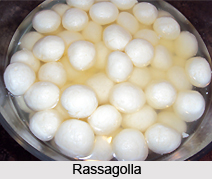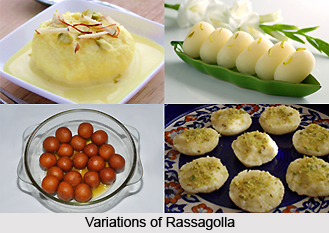 Rassagolla is a famous sweet of West Bengal and is also well admired in Odhisa where it is called `Rosogola` and the original sweet has a nice cream colour. This sweet is called `Roshogolla` in Bengali and `Rasgulla` in Hindi. With the amalgamation of culture and tradition, the sweet tradition of Bengal and Odhisa received appreciation in other states of India as well.
Rassagolla is a famous sweet of West Bengal and is also well admired in Odhisa where it is called `Rosogola` and the original sweet has a nice cream colour. This sweet is called `Roshogolla` in Bengali and `Rasgulla` in Hindi. With the amalgamation of culture and tradition, the sweet tradition of Bengal and Odhisa received appreciation in other states of India as well.
History of Rassagolla
The history of Rassagolla says that one of the most popular sweetmeats in India was originated from the Eastern part of the country and carries an interesting modern history.
According to some historical evidences, this sweet has got its name from Karnataka. This particular dessert is derisively attached to the Bengalis. This sweet can be found in almost all Eastern Indian households and in sweet shops. However, its birthplace was in the temple town of Puri in the eastern state of Odisha, where it has been eaten since medieval times. The best Rasagollas in Odisha are from the town of Salepur near Cuttack. Another variety made at Pahala near Bhubaneswar is also equally famous. In the town of Puri in coastal Odisha, Rassagolla is considered a traditional offering to the Hindu goddess, Lakshmi, the consort of main deity of the Puri temple, Lord Jagannath. The custom of the Jagannath temple of Puri is to offer Rasagollas to the Goddess Lakshmi to conciliate her wrath for ignoring her, after the commencement of the annual chariot festival which is locally called `Rath Yatra`.
The recipe for preparing Rasagollas was introduced to Bengal eventually by Odisha. During the Bengal renaissance, Brahmin cooks who were famed for their culinary skills and commonly referred to as Oriya Thakurs of Odisha, especially from Puri, were appointed in richer Bengali households to prepare foods for the upper class. With the Brahmin cooks of Odisha, the traditions of the state were amalgamated with that of Bengal and Oriya delicacies were assimilated into the Bengali kitchen.
In 1868, Nobin Chandra Das of Bagbazar, Kolkata, modified the original recipe of Rassagollas to take a pace further and extended the market value of this highly demanded sweet. This modification made the Rasagollas somewhat spongier and tougher and also enhanced the taste of the sweet. Later, the canned Rasagollas were introduced by K. C. Das, the son of Nobin Chandra Das and made the sweet to broaden its availability in other parts of the country. Afterwards, Haradhan Maira introduced the recipe of Rassagollas in Bengal in place of Nobin Chandra Das. The continuous practice of making this sweet has expanded the market of Rassagollas and its demand all over the world. The progression of time and the introduction of new methods of preservation have enlarged the accessibility of the Rassagollas. Now this sweet is found in most parts of the world even in Pakistan and Bangladesh, as well as in South Asian grocery stores in Britain and North America marketed by the renowned confectioners like K.C. Das and some famous sweet makers from Bikaner and Delhi.
 Variations of Rassagolla
Variations of Rassagolla
Rassagolla has a few variations like the Pahala variant of Odisha and the `kheermohan` of Bengal which is bigger in size than the usual Rassagollas. There are some Rassagollas made of jaggeries that are found in Bengal and Odisha during celebrations. Rassagollas are the precursor to many other sweets like the `rasmalai`, `raskadam`, `chamcham`, `pantua`, `malai chop` and the `kheersagar`. The traditional sweet making in Odisha allows implanting a single raisin or cashew inside each Rassagolla and a cardamom seed to enhance the flavour and add a fragrance. The sweet makers of Northern India prepare the sweets that come in different flavours of saffron, rosewater, and sometimes garnished with chopped pistachios.
Recipe of Rassagolla
The recipe that is followed by the sweet makers of India incorporates some basic ingredients like milk, citric acid, sugar, water and rose essence. The ingredients are needed in actual proportionate to make Rassagollas. The recipe of it is as follows:
Ingredients of Rassagolla
•1 litre milk
•1/2 tsp. citric acid
•1 1/2 cups sugar
•4 cups water
•2-3 drops rose essence
Method of Preparing Rassagolla: Heat the milk and bring to boil. Cool the milk for a couple of hours. Remove the cream layer. Heat the milk and bring to a boil. Add the citric acid dissolved in some water. Stir slowly till the milk is fully curdled. Keep as it is for 5 minutes. Meanwhile heat the sugar and water in a wide sauce pan. Bring to a boil. Strain the milk through a muslin cloth. Wash the chenna in the cloth under cold running water. Press out the excess water and remove in a wide plate. Gently knead into soft dough by passing between fingers. Make twelve equal sized balls of the dough. Let them into the boiling water. Cover with a perforated lid. Boil for 13 to 15 minutes. Take off from heat and cool them to room temperature. Add essence and chill for at least 4 to 5 hours.




















